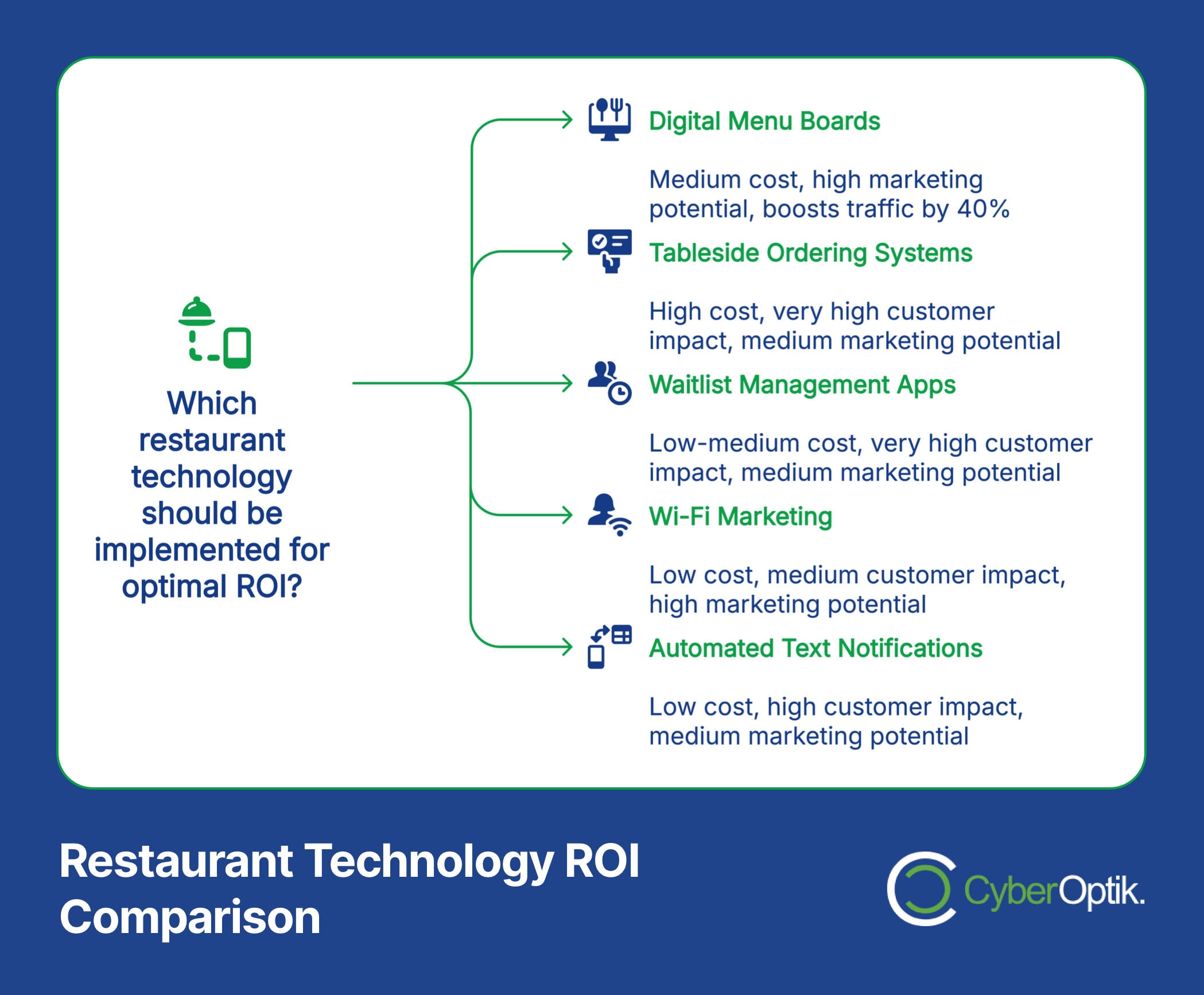The restaurant industry has always been competitive. Today’s restaurants face challenges from changing consumer preferences, delivery apps, and an increasingly digital marketplace. Effective marketing is no longer optional—it’s essential for survival and growth. As a digital marketing agency working with restaurant clients, we’ve identified strategies that consistently drive both foot traffic and online orders.
While food quality remains paramount, even the most delicious dishes won’t bring in customers if no one knows about them. In this guide, we’ll explore proven marketing approaches that help restaurants stand out, connect with customers, and ultimately increase revenue through both in-person dining and online orders.
These strategies work for establishments of all sizes, from small independent cafes to large restaurant chains. Let’s dive into the most effective restaurant marketing techniques that drive measurable results.
Digital Presence: The Foundation of Restaurant Marketing
A strong digital presence forms the foundation of effective restaurant marketing. Research shows that 90% of diners research restaurants online before visiting. (Source: Electro IQ) This statistic highlights why investing in your online presence isn’t just beneficial—it’s essential.
Your restaurant’s website serves as your digital storefront. It should showcase your menu, location, hours, and ambiance while making it easy for customers to make reservations or place orders. We recommend ensuring your site loads quickly, displays properly on mobile devices, and includes high-quality food images that accurately represent your offerings.
User experience matters tremendously for restaurant websites. Potential customers should be able to find critical information within seconds. A clear call-to-action for reservations or online ordering should be visible on every page.
Leveraging Social Media Platforms
Social media has become indispensable for restaurant marketing. Data indicates that 91% of restaurants use Facebook and 78% use Instagram for promotions. (Source: Toast POS) These platforms allow restaurants to showcase their food, ambiance, and special events while engaging directly with customers.

Visual content performs exceptionally well for restaurants. Food photos, behind-the-scenes kitchen footage, and staff introductions help humanize your brand. Regular posting keeps your restaurant top-of-mind with followers who might be deciding where to eat.
Each social media platform serves a different purpose in your marketing mix. The table below outlines how restaurants can effectively leverage various platforms:
| Platform | Best Content Types | Posting Frequency | Key Benefits for Restaurants |
|---|---|---|---|
| Events, promotions, longer videos, customer stories | 3-5 times weekly | Reach local customers, promote events, gather reviews | |
| Food photos, plating videos, ambiance shots | 5-7 times weekly | Visual showcase, younger audience reach, Stories feature | |
| TikTok | Recipe reveals, kitchen techniques, staff personalities | 3-5 times weekly | Viral potential, reach Gen Z, behind-the-scenes content |
| Industry insights, staff achievements, community involvement | 1-2 times weekly | Corporate catering opportunities, B2B connections |
When creating social media content, focus on authenticity over perfection. Today’s consumers appreciate genuine content that showcases your restaurant’s personality and values. Consider implementing a content calendar to maintain consistency across platforms.
Location-Based Marketing Strategies
Location-based marketing helps restaurants target potential customers in their immediate vicinity. This approach is particularly effective for driving spontaneous visits from people already in your area.
Geofencing campaigns increase foot traffic by targeting nearby customers with timely offers. (Source: Blis) These campaigns create a virtual boundary around your restaurant or specific areas where potential customers might be. When smartphones enter these zones, users receive notifications about your restaurant’s special offers.
Strategic implementation of geofencing can significantly boost lunch rushes or slow periods. For example, targeting office buildings during lunch hours or entertainment venues around dinner time can draw in customers who might be deciding where to eat.
Google Business Profile Optimization
Your Google Business Profile significantly impacts local search visibility. When potential customers search for “restaurants near me,” a well-optimized profile increases your chances of appearing in the valuable map pack results.
Complete all profile sections with accurate information, including:
- Business hours (with special holiday hours)
- Complete menu with prices
- High-quality photos of food, interior, and exterior
- Correct location pin on the map
- Attributes like “outdoor seating” or “offers delivery”
Actively managing online reviews is equally crucial. Respond professionally to both positive and negative feedback. Thank positive reviewers and address concerns raised in negative reviews with solutions. This demonstrates that you value customer feedback and continuously work to improve the dining experience.
Implementing a strong local SEO strategy helps ensure your restaurant appears in relevant searches. Include location-specific keywords throughout your website content, meta descriptions, and image alt text. Creating content about local events or neighborhood guides can also improve local search visibility.
Menu Engineering and Promotion Tactics
Strategic menu design and promotion can significantly influence customer ordering decisions and overall restaurant performance. Menu engineering involves analyzing item popularity and profitability to determine optimal placement and pricing.
Lunch specials and themed dinners effectively balance weekly traffic patterns. (Source: UpMenu) These promotions create specific reasons for customers to visit during traditionally slower periods. For example, “Taco Tuesdays” or “Wine Wednesdays” can transform slow weekday evenings into reliably busy shifts.
Seasonal menu updates keep your offerings fresh and give customers new reasons to return. They also allow you to capitalize on seasonal ingredients when they’re at peak freshness and lower cost. Promote these limited-time offerings through all marketing channels to create urgency.
Effective Use of QR Codes and Digital Menus
Digital menu adoption has accelerated in recent years, with data showing that 60% of patrons use QR code menus or promotions. (Source: Menu Tiger) These digital tools offer several advantages beyond contactless ordering.
QR codes can link to more than just menus. They can direct customers to:
- Your loyalty program registration
- Special promotional offers
- Customer satisfaction surveys
- Social media profiles
Digital menus also allow for dynamic updates without reprinting costs. You can adjust prices, highlight specials, or remove out-of-stock items in real-time. Additionally, digital menus can include rich media like food photos or preparation videos that enhance the customer experience.
The table below compares different promotional tactics and their effectiveness for restaurants:
| Promotion Type | Best For | Implementation Difficulty | Typical Response Rate |
|---|---|---|---|
| Happy Hour | Increasing early evening traffic | Low | High |
| Themed Dinner Nights | Boosting slow weekday traffic | Medium | Medium-High |
| Prix Fixe Menus | Increasing check averages | Medium | Medium |
| Limited-Time Offers | Creating urgency and social media buzz | Low | High |
| Buy-One-Get-One (BOGO) | Quick traffic boosts during slow periods | Low | Very High |
When implementing promotions, track performance metrics carefully. Each restaurant has unique customers who respond differently to various offers. Testing different promotions and analyzing the results helps optimize your marketing budget over time.

Online Ordering and Delivery Optimization
Online ordering has become essential for restaurant success. Research indicates that direct website orders have 30% higher average value than phone or over-the-counter orders. (Source: 7Shifts) This significant difference highlights the importance of optimizing your digital ordering system.
Many restaurants rely on third-party delivery platforms for online ordering. While these services offer convenience and exposure, they typically charge 15-30% commission fees that cut into profitability. Implementing a direct ordering system through your website can significantly reduce these costs while building direct customer relationships.
When setting up online ordering, ensure the system integrates smoothly with your point-of-sale software. This integration prevents errors and streamlines operations during busy periods. The ordering process should be intuitive, mobile-friendly, and require as few clicks as possible to complete a purchase.
Maximizing Check Size Through Digital Channels
Digital ordering systems create unique opportunities to increase check averages. Strategic design of your online menu can influence customer purchasing decisions in ways that aren’t possible with traditional paper menus.
Effective techniques for increasing digital order values include:
- Suggesting complementary items (drinks with entrees, desserts at checkout)
- Creating meal bundles or family packages at attractive price points
- Offering upgrades or customizations with clear visual presentation
- Implementing minimum order requirements for delivery with suggested items to reach thresholds
The data below shows how different online ordering approaches compare in terms of profitability and customer experience:
| Ordering System | Implementation Cost | Commission Fees | Customer Data Access | Average Check Impact |
|---|---|---|---|---|
| Third-Party Platforms | Low (Free to set up) | High (15-30%) | Limited or None | Baseline |
| Website Integration | Medium ($1,000-$5,000) | Low (2-5%) | Complete | +15% to +30% |
| Custom Mobile App | High ($10,000+) | Minimal (1-3%) | Complete | +20% to +40% |
| Hybrid Approach | Medium-High | Variable | Partial to Complete | +10% to +25% |
Beyond system selection, optimizing delivery zones based on population density and operational capabilities helps maintain food quality and customer satisfaction. Consider implementing tiered delivery fees based on distance or order minimum requirements to ensure profitability.
Loyalty Programs and Customer Retention
Customer retention strategies typically offer higher ROI than acquisition efforts. Loyalty programs provide a structured way to encourage repeat visits while collecting valuable customer data.
Among top-performing restaurants, 92% combine mobile ordering with loyalty programs to maximize customer retention. (Source: Toast POS) This integration creates a seamless experience where customers earn rewards through their normal ordering behavior without requiring additional steps.
When designing a loyalty program, focus on simplicity and meaningful rewards. Points systems work well, but ensure the value proposition is clear and attainable. For example, “Spend $100, get $10 off your next visit” is more transparent than “Earn 1 point per dollar toward future rewards.”
Email Marketing for Restaurants
Email remains one of the most cost-effective marketing channels for restaurants. It provides direct access to customers without algorithm constraints or platform fees.
Birthday emails achieve 14.68% higher open rates than standard promotional emails. (Source: Tablein) This significant increase in engagement makes birthday rewards particularly effective for bringing customers back. Collect birth dates during loyalty program registration to enable these targeted campaigns.
Beyond birthdays, effective restaurant email campaigns include:
- New menu announcements
- Special event invitations
- Limited-time offers
- Holiday promotions
- Customer appreciation discounts
The table below outlines different loyalty program models and their effectiveness for various restaurant types:
| Loyalty Program Type | Best For | Technology Required | Customer Adoption Rate | Impact on Visit Frequency |
|---|---|---|---|---|
| Points-Based System | Full-service restaurants | POS integration | Medium | 10-15% increase |
| Visit Frequency (Buy 10 Get 1 Free) | Coffee shops, quick service | Simple app or punch card | High | 15-25% increase |
| Tiered VIP Program | Fine dining, high-end establishments | CRM system, reservation integration | Low-Medium | 5-10% increase, 20%+ higher spend |
| Subscription Model | Fast casual chains | Payment processing, app integration | Low | 30-50% increase for subscribers |
Segment your customer database for more personalized marketing. Customers who typically visit for lunch might respond differently to promotions than those who prefer dinner service. Analyzing ordering patterns allows for highly targeted offers that resonate with specific customer groups.
Event Marketing and Community Engagement
Special events give customers specific reasons to visit your restaurant while creating memorable experiences that build brand loyalty. Data shows that 53% of restaurants invest in community events as part of their marketing strategy. (Source: Toast POS)
Themed dinner events work particularly well for driving traffic during traditionally slow periods. Wine pairing dinners, chef’s tasting menus, holiday celebrations, and cuisine exploration nights create unique experiences that justify premium pricing while filling tables.
Beyond in-house events, community involvement builds goodwill and local recognition. Participating in food festivals, sponsoring local sports teams, or supporting charity events positions your restaurant as a valued community member while creating brand awareness.
Using Technology to Enhance In-Store Experience
Strategic technology implementation can significantly improve the in-restaurant experience while supporting marketing efforts. Website speed and functionality are critical to capturing online visitors and converting them to in-person diners.
Digital signage boosts midweek traffic by 40% when used to promote specials and events. (Source: 7Shifts) These dynamic displays capture attention more effectively than static signage and can be updated instantly to feature different promotions throughout the day.
Technology integration should enhance rather than replace the human element of hospitality. Self-ordering kiosks, tableside payment systems, and waitlist management apps work best when they free staff to focus on creating exceptional guest experiences rather than handling routine transactions.
Consider how various technologies impact different aspects of the restaurant experience:
| Technology | Primary Benefit | Implementation Cost | Customer Experience Impact | Marketing Potential |
|---|---|---|---|---|
| Digital Menu Boards | Dynamic promotion of high-margin items | Medium | Medium | High |
| Tableside Ordering Systems | Increased order accuracy and speed | High | High | Medium |
| Waitlist Management Apps | Reduced perceived wait times | Low-Medium | Very High | Medium |
| Wi-Fi Marketing | Customer data collection | Low | Medium | High |
| Automated Text Notifications | Improved table turnover | Low | High | Medium |
The right technology investments should address specific operational challenges while supporting your marketing objectives. Prioritize solutions that enhance the customer experience while providing measurable returns on investment.
Data Analysis and Marketing Optimization
Data-driven decision making separates thriving restaurants from struggling ones. Research shows that 64% of operators use customer behavior data to inform their promotional strategies. (Source: WebstaurantStore) This approach enables more targeted marketing and better resource allocation.
Key metrics to track for restaurant marketing effectiveness include:
- Customer acquisition cost (CAC)
- Customer lifetime value (CLV)
- Promotion redemption rates
- Table turnover rates
- Average check size
- Return visit frequency
Modern POS systems capture valuable data about ordering patterns, peak hours, and customer preferences. This information helps optimize staffing, inventory, and marketing efforts. Integrating your POS with your customer relationship management (CRM) system creates a comprehensive view of each customer’s history with your restaurant.
Implementing AI and Automation
AI and automation technologies are transforming restaurant marketing. Among industry leaders, 45% of operators use AI for various aspects of kitchen operations and customer service. (Source: National Restaurant Association) These technologies optimize processes while creating new marketing opportunities.
Practical AI applications for restaurant marketing include:
- Predictive analytics for inventory management and staffing
- Chatbots for reservation assistance and frequently asked questions
- Automated email campaigns triggered by customer behavior
- Dynamic pricing based on demand patterns
- Personalized menu recommendations based on order history
Technology adoption continues to create competitive advantages, with 76% of operators crediting technology investments with improving their market position. (Source: National Restaurant Association) As these tools become more accessible, even small independent restaurants can leverage sophisticated marketing capabilities previously available only to large chains.
When evaluating new marketing technologies, assess both implementation costs and ongoing maintenance requirements. The ideal solutions integrate with your existing systems while providing clear metrics to measure return on investment.
Conclusion: Creating an Integrated Restaurant Marketing Strategy
The most successful restaurant marketing approaches integrate multiple strategies rather than relying on isolated tactics. When digital presence, location-based marketing, promotional offers, online ordering, loyalty programs, events, and data analysis work together, they create a comprehensive system for attracting and retaining customers.
Looking ahead, industry data suggests that 47% of operators plan to implement new discount and promotion strategies in 2025. (Source: National Restaurant Association) This trend reflects the continuing importance of promotional marketing in a competitive landscape.
As consumer behaviors evolve, restaurants must adapt their marketing approaches accordingly. The strategies outlined in this guide provide a framework for developing a comprehensive marketing plan that drives both foot traffic and online orders.
At CyberOptik, we work with restaurant clients to implement these strategies through effective web design and digital marketing services. Our approach focuses on creating seamless customer experiences that bridge online engagement and in-person dining.
The restaurant industry continues to face challenges, but with strategic marketing investments and a data-driven approach, operators can build resilient businesses that thrive in any economic environment. By implementing these proven strategies, your restaurant can increase both foot traffic and online orders while building lasting customer relationships.




